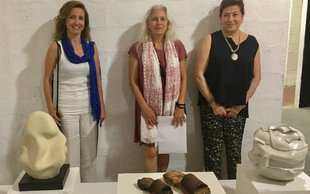
Taking Lebanese Ceramic Art to a Higher Place
Ceramics is getting more and more popular and this competition proved us...
The fields marked with * are mandatory
Beirut has long been a sanctuary for artists from Lebanon and abroad
Beirut has long been a sanctuary for artists from Lebanon and abroad. The ancient city feeds the soul with beautiful sceneries with its timeworn and joyful architecture, the sights of people walking down the pavement by the sea and the occasional greenery here and there. Hasan Jouni has found Beirut to be his biggest muse, as in his art, Beirut is always present despite the theme he’s conveying.
Jouni was born in Beirut, Lebanon, in 1942. He studied at the Academy of Fine Arts in Beirut and then in Spain before receiving a grant to continue his studies abroad. As he explains, back in the mid-60’s, there was such a grant given to one student from every faculty from across Lebanon. He was chosen from the faculty of fine arts and thus continued his higher studies in Spain, again. “The study of art is very simplified here and more liberal, unlike that of abroad. It’s hard, in every way possible. The curriculum was strict there,” he said, talking about his experience studying overseas. “We had to finish and pass 23 subjects. Failing one subject means failing the year, and what made it even trickier for me was the fact that I was on a scholarship and had no intention of losing the grant,” he continues. The grant itself was difficult to obtain and thus, became a source of pride for him. Today, Jouni is proudly mentioned in the Benezit, dictionary of artists.
“In my art, I like to portray different stages and subjects,” says Jouni when asked about his art. All over his vintage house, different paintings are scattered here and there, some of buildings that represent the old Beirut Jouni holds dear to his heart and others of passers-by on the Corniche and of things he’d observe on the many branched out streets of little Beirut. On the door of his entrance are writings in Arabic. “Tell me what you dream, I’ll tell you who you are” and “Take from life before life takes from you” are only a few of the many phrases scattered on the big beige door.
He described his old Beirut so intricately and intimately using phrases like “the Magnolia flower was Beirut’s perfume”. He painted a mental picture of vintage white buildings, green shutters and high ceilings. His love for this city is present in many of his themes, even those relating to love, lust and passion. Mainly, he focused on portraying the golden age of Beirut, the age of yellow bus rides, long walks by the beach and coffee shop meetings. In themes of love, he focused on how love used to be, not how it is today; how lovers in Beirut would write each other love letters and hold hands only in the dim cinemas. “An expressive artist does not just pass by his theme, we draw to raise an issue or a certain point and to attract attention,” he said. “Back then, when a man loved a woman, he really loved her. He would wait for her and write poetry for her, not like today, cheat on her, degrade her and then leave her” he added.
“Painting has become a hard profession. A piece of art without fame is hard to live off,” he says. Only one of his grandchildren is interested in this hobby, something he both loves and loathes. His two daughters are married and his son has grown up but none have taken to the art of painting. “In art, there’s only a talent that God instills in you” he comments. The different colorful paintings distributed in his apartment added a hint of life to the old house. Through the window of the room where he paints, a majestic view of the blue ocean and the golden sun meets the eyes. “This is what I love about this place, about Beirut” he said. “It’s beautiful”.
Articles
Lebanon
Art
Arts
Painting & Drawing
Get updates on what's happening in Beirut, customise and review the content you want.
Sign up now! It's free!